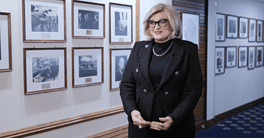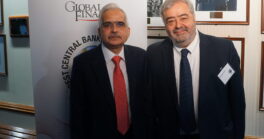With technology and customer expectations changing rapidly, financial institutions are embracing innovation to meet the financial needs of the future.
Here, in what has become an annual rite, we name our picks for the world’s most innovative banks, most innovative fintechs, and the greatest financial innovations of the past year. To make these selections, a team of Global Finance editors and researchers pore over entries submitted by banks as well as public documents and news reports to identify leading edge institutions, and talk with finance industry veterans with longtime perspectives. This is our eleventh year putting together this popular report.
While innovation isn’t always tied to technology, in recent years developments in AI, distributed ledger and cloud computing have made tech the driving force of innovation, especially in the finance sector. Banks need to work smarter and provide a wider range of services to their customers. Financial institutions have been moving to address the challenge. Last year, the global retail banking industry was on target to spend $250 billion on technology, according to Celent, which projects that IT spend to rise around 5% per year, and hit $308 billion by 2027. The types of technologies that financial institutions are betting on are a blend of new and old, but the applications are unique. Many are focusing on artificial intelligence and in particular, machine learning. Whether in products developed in a lab, incubator, or accelerator, or through the bank’s own technology department, AI has been an integral tool in areas such as fraud detection, data security, call center management, and back-office processes like SWIFT messaging.
Banks are improving and simplifying processes so that they require less time and reduce carbon footprints. Processes and services increasingly incorporate biometrics to identify customers remotely. Others are aimed at eliminating paper and further embracing the digital world through digital know-your-customer (KYC) functions that facilitate opening new accounts for existing clients by leveraging existing customer data. Along with KYC functions, banks are innovating to assist anti-money laundering compliance as new laws tighten up, creating a need to align data security with the new legal regime.
Commercial customers need more services. Digital portals and cash management applications help them manage their finances, and banks with existing products are looking to add functionality such as access to third-party systems for enterprise resource planning and human resources and AI-powered insights into cash flows and reconciliations. Banks are also continuing to develop APIs that connect systems and data.
Financial institutions are looking at ways to bolster the SME sector, critical to so many economies, including training entrepreneurs to successfully operate their businesses and obtain funding from banks. Many banks focuse on developing women entrepreneurs because research shows women’s engagement has profound impact on the wider economy and their communities.
Many established banks are embracing a startup culture, encouraging staff to think through new solutions to age-old problems and develop new products. It’s not just about making life easier for customers or eliminating pain points for employees; innovation often leads to savings in time and money for both employees and customers. Banks can do more with less.
Innovation doesn’t happen overnight, however. “It’s an iterative process, Nick Kerrigan, head of innovation execution at SWIFT, said during a recent LinkedIn Live session. “The more we can learn from each other, the better.”
World’s Most Innovative Banks 2023
| Bank of America |
| DBS |
| HSBC |
| JP Morgan |
| SEB |
Bank of America
Last year, Bank of America (BofA) spent just over $11 billion on technology and enjoyed another record-breaking year for patents granted. BofA continued to push innovation, with 608 new patents—a 19% increase year over year—covering artificial intelligence (AI), machine learning (ML), information security, data analytics, mobile banking and payments, and making it one of our top five picks for most innovative bank of 2023.
BofA boasts 70,000 technologists globally—roughly a third of its workforce—yet it does not have an innovation lab. “We don’t want individuals to think innovation is just for a single group of people,” says Andrew McKibben, international head of BofA’s Technology & Operations. “Every person is empowered to innovate.”
BofA also promotes innovation by encouraging varied approaches to problem-solving. “If we create enough diversity [of thought], from a productivity perspective we will benefit,” McKibben argues. “We’re also really focused on neurodiversity conditions, as a broader selection of employees will often see problems in very different ways.”
BofA’s Global Transaction Services business has been particularly busy over the past year, implementing innovations for corporate treasury teams aimed at optimizing working capital.
“With so much innovation occurring, it takes a team like ours that is 100% focused on payments innovation to help identify the solution that could have the most impact on a company’s treasury operations and bottom line,” says Faiz Ahmad, head of BofA’s Global Transaction Services. “Not all companies are at the same point in their technology evolution.”
Last year, the bank introduced Pay by Bank, which enables customers of e-commerce companies, initially in the UK, to pay directly from their bank account; IXP (international cross-border payments), which uses distributed ledger technology to enable near real-time initiation and disbursement of low-value, high-volume cross-border payments; and a simplified sign-on method called CashPro QR Sign-on.
Meanwhile, BofA’s wealth management team is modernizing how people find a financial adviser with Merrill Advisor Match, because, as Jennifer Auerbach-Rodriguez, head of Merrill’s client acquisition and strategic growth initiatives, says, “not everyone has an adviser in their personal network.”
DBS
With wins in nine award categories this year, DBS has not lost its appetite for innovation. Even more impressive, the nominations honored multiple areas of the bank, putting this Asian powerhouse among the world’s most innovative banks yet again.
Middle-office technology rarely gets noticed but has huge potential for impact. Finding no off-the-shelf solution in the marketplace, DBS developed AutoFin (automated financial analysis), which leverages computer vision, natural language processing and deep learning technologies to ease the analysis and client writing tasks so that relationship managers can spend more time nurturing client relationships. The DBS Data Protection Analytics team now deploys ML and data visualization to detect misuse and abuse of customer information. And the bank’s Geolocation Real-Time Fraud Detection is an industry-first tool that cross-checks customer locations with the point-of-sale terminals where payment transactions occur.

User experience was another fertile area of innovation at DBS last year. The bank built an API to automate manual processing and provide instant updates to customers. The Intelligent Business Process Manager is the first API in banking to consolidate and incorporate different technologies, systems and platforms. The digitization of a consumer banking customer’s journey, meanwhile, is Singapore’s first digital application and onboarding vehicle for unsecured financial products such as renovation loans and debt consolidation.
Finally, the DBS Digital Currency Unit in the fall unveiled DBS Purpose Bound Money, Singapore’s first programmable money built on a public blockchain, which enables a client to program, launch and distribute conditional vouchers.
HSBC
HSBC launched three major innovations last year, covering market trading, bond issuance and trade finance—the three pillars of the bank’s core objective of “opening up a world of opportunity” for clients. HSBC AI Markets is the first natural language–based system that generates bespoke cross-asset data and analytics on the financial markets alongside pricing and execution, delivered over a variety of digital channels. The system aims address four pain points: access to liquidity and content, access to data, automation and insights. AI Markets provides on-demand analytics, execution and market intelligence to both internal HSBC staff and external clients.
Introduced in the fall, HSBC Orion is a proprietary tokenization platform that uses blockchain technology to issue digital bonds. Last fall, HSBC Trade Solutions (HTS) was launched in partnership with CGI, allowing clients to originate and manage all their trade finance products online. HTS leverages an API-native, modular design and flexible tech stack as the backbone of the bank’s market-leading trade offering, supporting $800 billion of global trade per year. Already deployed in the UK and Hong Kong, HTS is now being introduced to additional markets across the HSBC network.
JPMorgan Chase
JPMorgan Chase’s technology spend in 2022 was $14 billion, of which approximately half was dedicated to investments—a substantial commitment to developing new services for the bank’s 62 million digitally active mobile users.
In his annual letter to shareholders, Chairman and CEO Jamie Dimon said that AI and the raw data that feeds it will be critical to the bank’s future success. In addition to a 200-person AI research group headed by Manuela Veloso, who previously led the ML department at Carnegie Mellon University, JPMorgan employs over 1,000 people in data management, more than 900 data scientists and 600 ML engineers. The bank also boasts 300 AI use cases in production for risk, prospecting, marketing, customer experience, fraud prevention, payments processing and money movement systems.
“We’re imagining new ways to augment and empower employees with AI through human-centered collaborative tools and workflow, leveraging tools like large language models, including ChatGPT,” Dimon wrote. With that in mind, JPMorgan has spent over $2 billion building new, cloud-based data centers and modernizing many of its applications—and their related databases—to run in both public and private cloud environments.
A partnership with QC Ware, a quantum-computing-as-a-service firm, is helping pave the way for the bank to incorporate quantum computing into its deep hedging activities. JPMorgan, Toshiba and Ciena Build, meanwhile, have joined forces to secure the bank’s mission-critical blockchain applications using the first quantum key distribution network.
Also last year, J.P. Morgan Wealth Management launched Wealth Plan, a free, digital money coach that gives clients a fuller picture of their finances and helps them plan, save and invest, and will be available for free to all Chase customers in the top-ranked Chase Mobile app and at Chase.com.
SEB
Sweden’s SEB established an innovation lab back in 2018, called SEBx and headed by Christoffer Malmer, who was broadly tasked with exploring new technology and building products. At the time, banking-as-a-service and embedded finance were not yet widely recognized concepts, he recalls, but this was exactly what SEBx developed.
“We put together a technology platform that we built in Google Cloud,” says Malmer. “It’s a cloud-native infrastructure, and we said from the beginning, whatever we’re building here, we should be able to share it both to internal distributors as well as external ones.”
The bank began using the platform to build a next generation of mobile apps for its younger customers and launched the external offering last year. Its first customer was Swedish retail conglomerate Axel Johnson, which wanted to build customer engagement for its various brands via a card loyalty scheme. Axel Johnson’s fintech startup, Humla, built the user experience, but everything banking related runs via APIs housed in SEB’s platform.
“We do the sanction screening, the financial monitoring, and the fraud prevention. We also constantly interact with [the customer] to make sure that things are in order,” Malmer says. “If you look at the retailer’s mobile app, however, you won’t see SEB mentioned anywhere: it’s an account-as-a-service, it’s a card-as-a-service, it’s a payment-as-a-service.”
SEB sees embedded finance as a natural development, since the technology has moved to a point where it can be implemented in a seamless, easy-to-use way. Driving the process is customer behavior and, to some extent, regulation. “When you take an Uber ride, you don’t pull out your wallet,” says Malmer. “You don’t make any payments, not even an approval. You just take the ride and step out of the car because that transaction is completely embedded, which is tremendously convenient.”
More new value propositions will be hitting the marketplace in relatively short order, Malmer predicts, noting a flurry of activity from fintechs aimed at facilitating embedded finance. SEB has an advantage, he adds, since it has the balance sheet, the capital, and is used to dealing with regulators, which add up to a higher risk tolerance and high standards for integrity and security. “We aspire to blend the best of both worlds,” he says.
World’s Most Innovative Fintechs 2023
| JUMO |
| MONET |
| Pomelo |
| SmartStream |
| Thought Machine |
JUMO
A South African technology company that develops tools for next-generation financial inclusion in emerging markets, Jumo in October launched VELA, a pioneering asset management engine built to give investors access to social-impact investments with a high standard of governance and control.
Underpinning VELA are Jumo’s artificial intelligence and machine learning capabilities, which enable it to allocate multicurrency funds—US dollars and cryptocurrency—to select portfolios. Qualified investors can put money to work alongside pan-African banks and watch it perform in real time.
Working with pan-African banks and mobile money partners in six African markets, Jumo is helping supply capital to small businesses in Africa. To date, the Jumo platform has been used to make 130 million loans, totaling $4 billion, to more than 20 million people and small businesses in Ghana, Uganda, Kenya, Tanzania, Zambia and Côte d’Ivoire.
MONET
The branded content industry—everything from sports uniforms to Disney figurines to print advertising campaigns to celebrity endorsements— is estimated to be worth $100 billion worldwide, although there is no agreed-upon definition for this constantly evolving space. Digital brand creators, who canny brands have discovered are far nimbler than slow moving advertising agencies, thanks to their ability to garner cyber clicks have to fight a lot harder for timely payment of brand dollars.
This is where MONET, a UK-headquartered B2B fintech player comes in—offering a modern invoice factoring platform for creator businesses who earn online via brands and monetization platforms.
In May of 2022, a beta launch of Monet’s revenue-based lending platform offered dedicated Creator Business debit cards and accounts for creators, providing an infrastructure for advertising agencies and influencer platforms to extend working capital finance to their globally distributed suppliers, and earning MONET a spot among the world’s most innovative fintechs.
Facilitating MONET’s platform is Weavr, an embedded finance specialist that provides business banking and payments infrastructure. MONET pays creators upfront on what they are owed from brand deals and platform earnings, pushing funds directly into the creator’s dedicated MONET current account, where they also receive 1% cash back on all business spending. MONET’s white label EarlyPay product, meanwhile, enables agencies and platforms to pay creators early, in their own branded solution.
Over 300 creator businesses joined the beta launch in the first month, while 7,500 creative businesses are on the wait list.
Pomelo
Founded in April 2021, Pomelo is building Latin America’s first regional fintech infrastructure platform, allowing companies to launch digital accounts and issue prepaid, debit, credit, crypto and corporate cards—among others—to their users and business customers. The Argentine company currently operates in six markets—Brazil, Mexico, Colombia, Argentina, Chile and Peru. It serves over 100 clients, including banks and tech unicorns such as Bitso; a Mexican crypto exchange; Rappi, a Colombian on-demand delivery startup; and Stori, a fintech that offers credit card products to underserved populations.
“Pomelo was designed to remove the largest pain points in the industry,” says Gastón Irigoyen, CEO and co-founder, “while allowing for modern use cases and meeting the technical requirements of technology companies and large enterprises operating in more traditional industries such as banking, retail, energy, real estate and agriculture.”
Pomelo’s infrastructure enables companies to launch and scale financial services within weeks, he says, “dramatically improving their go-to-market as well as saving years of work, thousands of people and millions of dollars. A single API-based integration with Pomelo allows any company to develop a regional fintech business with the highest standards of cybersecurity and compliance.”
Pomelo’s platform attracted $60 million in investment in the company’s first 18 months. The attraction is its promise to solve many of the problems that nag Latin America’s expensive, highly fragmented payments infrastructure, providing a better experience for end users and helping the region’s fintechs to grow.
Smartstream
SmartStream Air V.7.0 was launched in the fall by the London-headquartered financial transaction management solutions provider of the same name. It uses AI technology for an intuitive, easy-to-use automated version of a common back-office function: reconciliations for exception management.
While UX is the mainstay of front-end operations, the back end is often overlooked, and Air V.7.0 made Smartstream the first recipient of a Red Dot Design Award for back-office financial applications.
Elena Savitskaya, director of User Experience and Design at Smartstream, points to the currently pressing challenges of cost reduction and talent retention at a time when “the quality of digital experiences we have come to expect outside of work is now also expected at work.” Self-service back-office platforms help employees achieve more, she adds, “all while having a positive experience within the solution, removing friction and frustration.”
Better UX in the back office means staff can focus on work with higher added value, Savitskaya says, while a gentle learning curve facilitates employee development, reducing workforce churn. “High user adoption rates driven by outstanding user experiences ultimately support the increasingly difficult-to-manage human factor in digital transformation success.”
Thought Machine
Vault Core, Thought Machine’s cloud-native core banking platform, enables banks to build and launch any financial product. Launched last year, Vault Payments provides a single platform on which institutions can run all their payments for every method, scheme and region worldwide—a bold move for a fintech. The goal, says COO Gareth Richardson, is to “significantly optimize the entire payment lifecycle for banks and their end customers.”
The London-based fintech’s larger aim is to extend Vault Core’s model into the payments space, which Richardson says it can transform in the same way it has core infrastructure. “Customers now expect digital-first, real-time, personalized services,” he notes. “Only by moving to modern, cloud-native technology will banks be able to meet these demands and stay ahead of the competition.”
Built from scratch as a cloud-native payments processing platform, Vault Payments is scalable, highly configurable and can operate in real time, according to Richardson. It represents payments as ISO20022 messages, he adds, and its rails-based configuration approach will support any payment type, card or payment scheme as compatibility expands. The platform can integrate any financial product with the Mastercard network through a payment routing mechanism and can be adopted as a standalone product and integrated into a variety of core banking systems.
World’s Best Financial Innovations 2023
Innovation | Bank |
|---|---|
| CargoWALLET | CargoAi |
| Use of blockchain to advance responsible AI | FICO |
| Fioneer Embedded Finance as a Service | SAP Fioneer |
| Interlinking CBDCs for seamless cross-border payments | Swift |
| OneKey Banking | Treasury Prime |
CargoWALLET
by CargoAi
Launched in 2019, Singapore-headquartered CargoAi remains the first and only air freight booking platform that uses data and AI to provide air cargo digital solutions for forwarders, airlines and general sales agents (GSAs).
While making a real-time cargo reservation online has become much easier in recent years, bureaucracy and other obstacles made it difficult to pay for the space—until CargoAi launched its unique payment solution, CargoWALLET, in February.
Founder and CEO Matt Petot says it took two years to design, build and test the platform. CargoWALLET connects with modern banking and payment providers to collect more than 30 currencies at the same cost as a bank transfer, providing supply chain financing solutions to freight forwarders with up to 60-day payment terms. CargoWALLET is a standalone solution that has been first validated on the company’s marketplace, CargoMART, but can be integrated into any airline, GSA or freight forwarder process flow.
CargoWALLET is tailored to empower small to medium-size freight forwarders. Shipments can be booked and paid for without an International Air Transport Association (IATA) Cargo Account Settlement Systems number, without an air waybill (AWB) and without any bank guarantee. Airline schedules, including cargo capacity, are displayed on CargoMART and freight forwarders can check schedules and compare rates in real time, then request quotes and make bookings via the platform.
“Not only does air cargo booking become more seamless, but the entire procurement from search, quote, booking and now payment can be done within minutes on just one interface,” says Magali Beauregard, chief customer officer at CargoAi. That means stakeholders of all sizes can “connect with each other in the digital air freight ecosystem and stay ahead in digital adoption.”
Use of Blockchain to Advance Responsible AI
by FICO
Data analytics provider FICO has been awarded 12 patents related to digital decisioning in the areas of blockchain model governance, AI and ML technology. Better insights result in better decisions, the company believes, and its patents pipeline shows how to keep pace with advanced analytics while maintaining a responsible approach to AI and ML.
Efficient Association of Related Entities identifies and tracks associations between related entities in a distributed computing environment to determine those known to be involved in fraud. Blockchain for Data and Model Governance is a shared ledger that tracks end-to-end provenance of the development, operationalization and monitoring of ML models in an immutable manner. Providing Insights About Dynamic Machine Learning Models encompasses the use of visual indicators of features and training data, along with global or local explanations, to provide a broader summarization of an ML model’s behavior.
Other new FICO patents address missing data, systems security and money laundering detection. Facial Recognition for User Authentication describes a system that continually scans facial movements indicative of the user’s liveness, as opposed to static representations. Deployment of Self-Contained Decision Logic delineates a process for generating executable code associated with a decision logic and making it amenable to storage in a repository.
A culture of innovation has helped FICO to develop unique intellectual property in AI operationalization, model governance and ML, driving “the operationalization of responsible AI capabilities,” says Scott Zold, the company’s chief analytics officer. That, in turn, “powers better decisions, increases revenue and provides more rewarding customer experiences for businesses worldwide.”
Fioneer Embedded Finance as a Service
by SAP
SAP launched Fioneer Embedded Finance as a Service (EFaaS) in March; it is the first B2B embedded finance platform that facilitates orchestration between SAP users and financial service institutions. The latter connect to SAP’s enterprise resource planning (ERP) processes, enabling customers to develop innovative embedded finance solutions tailored to their corporate clients’ specific needs, all on one centralized platform.
“As B2B trade is increasingly digitized, the expectation is to embed relevant financial services natively within the context of that business transaction,” notes Vishal Shah, head of Embedded Finance at SAP Fioneer. This trend is fueling innovation across both physical and financial supply chains. “Traditional financial institutions leverage these B2B channels as cost-efficient distribution channels,” says Shah. “Emerging fintechs unlock new business models. And this timely and efficient access to a much-needed financial service ultimately helps companies remain financially and operationally resilient.”
EFaaS support several use cases, including buy now pay later (BNPL), request to pay (R2P), purchase order finance and invoice finance. “B2B payment offerings that help improve accounts payable and accounts receivable operations are proving the most popular,” says Shah. “Now, financial institutions are focused on delivering more digital and on-time financial services to the corporate treasury.” As a next step, he predicts, financial institutions will extend their offerings to enterprise sales and the procurement function.
Interlinking CBDCs for Seamless Cross-Border Payments
by SWIFT
Innovations at SWIFT come thick and fast. But with 105 countries currently exploring centralized digital currencies, SWIFT’s efforts to devise an interoperable transactions process for both central bank digital currencies (CBDCs) and existing financial infrastructure and to enable asset tokenization stood out from its other innovations last year.
Following a successful eight-month trial involving the technologies and currencies of several central banks and commercial banks, SWIFT announced in October that it had solved the problem of interoperability in cross-border transactions by bridging different distributed ledger technology (DLT) networks and existing payment systems, “allowing digital currencies and assets to flow smoothly alongside, and interact with, their traditional counterparts.” SWIFT then deployed the new solution in a sandbox environment and opened it up to 18 central and commercial banks to test it over a 12-week trial period.
“Innovation is always an iterative process,” Nick Kerrigan, head of innovation execution at SWIFT, said during a recent LinkedIn Live session. “So, the more we can learn from each other, the better.”
SWIFT aims to forestall fragmentation of the digital payments system, Kerrigan says, as central banks look to CBDCs to solve social and economic challenges, variations of technology standard protocols and even differences between retail and wholesale banking.
“Interoperability should be designed from an early stage, rather than thought about afterward,” Kerrigan argues, “because we don’t want to have disconnected digital islands. We want to have instant and frictionless payments, and for that to be smooth—whether it’s with a CBDC or whether it’s with some other form of digital currency or a traditional form of fiat currency.”
SWIFT also carried out a successful, separate trial with Citi, clearing house Clearstream and Northern Trust on “tokenized’ assets,” demonstrating how traditional assets such as stocks and bonds can be transformed into digital tokens that can then be issued and traded in real time.
OneKey Banking
by Treasury Prime
Treasury Prime is a banking-as-a-service (BaaS) company based in San Francisco that connects banks and fintechs through an API. The launch of OneKey Banking in March enables Treasury Prime customers to use instant cross-bank transfers (network transfers) to access a bank network that consists of over 15 financial institutions.
As companies mature, their growth can outpace their BaaS solution. OneKey Banking allows customers to develop embedded banking solutions with multiple bank partners, manage deposits among banks and diversify risk, all via a single, unified API interface. Enterprises can choose the best banking partner for a particular product or service and move money between banking partners instantly.
“OneKey Banking brings us that much closer to our vision of creating a de facto banking standard for our partner banks,” says Chris Dean, Treasury Prime CEO and co-founder. “An enterprise can treat its partner banks as a true network.”
If a customer is building a product at their current sponsor bank that is missing a critical feature, they can simply try another Treasury Prime banking partner. Similarly, if a company requires more deposit capacity to support its growth, it can get it by accessing another Treasury Prime banking partner.



